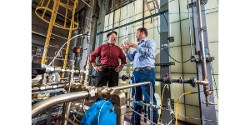The Palo Verde Nuclear Generating Station near Phoenix converts heat from nuclear reactions into electricity. The heat boils water, creating steam that drives turbine generators. Steam leaving a turbine must be cooled and condensed before it is reused.
More than 40% of all the water used in the country is for wet cooling at power plants. Typically, large thermoelectric power plants are located near lakes or rivers so that operators can draw a regulated amount of water, run it through a condenser to cool steam leaving the turbines, and discharge roughly the same amount they withdrew.
But the Palo Verde plant has limited access to water because it is in the middle of a desert. Its cooling water is treated wastewater, which is becoming increasingly expensive as other customers who are willing to pay higher prices for water emerge. To curb rising costs, operators want to reduce the plants water use by about 9 million gallons a day. Annually, that savings is roughly equivalent to a 16 square mile pool of water one foot deep, said Bobby Middleton, a nuclear engineer at Sandia.
To reduce the plants water use, operators at Palo Verde first looked at commercially available solutions. When they realized that nothing available could meet their needs, they turned to Sandia Labs to help identify which cooling systems under development might eventually offer the greatest water savings.
To evaluate different emerging technologies, Middleton developed software that combines the physics of the cooling process such as fluid flow, heat transfer, atmospheric evaporation and water treatment with the financial impact of different solutions.
The wastewater that arrives at Palo Verde contains silica, calcium, magnesium and phosphate ions. These salts concentrate as the cooling water evaporates in the cooling system, possibly forming new minerals that might clog the cooling towers. Currently, operators add lime, soda ash and acid to the wastewater before it enters the cooling tower to reduce the possibility of mineral formation.


